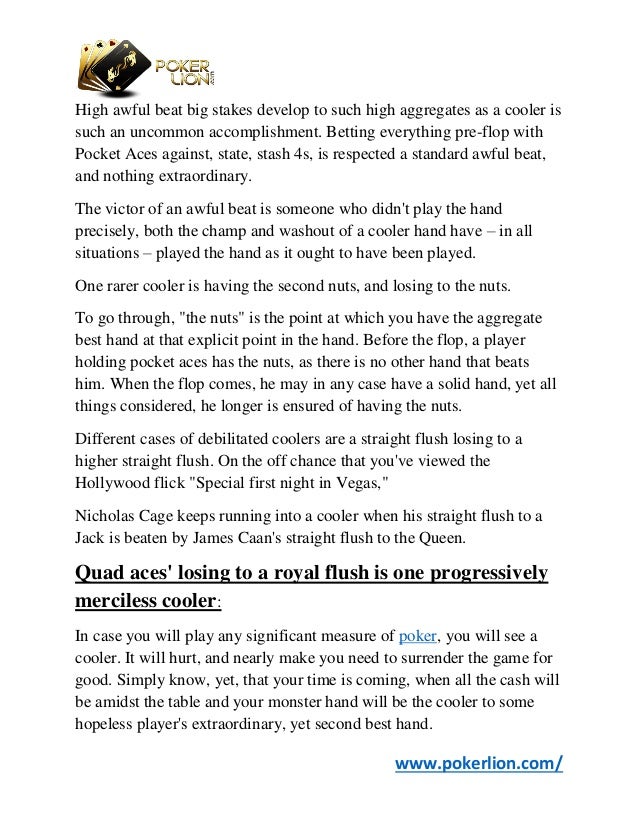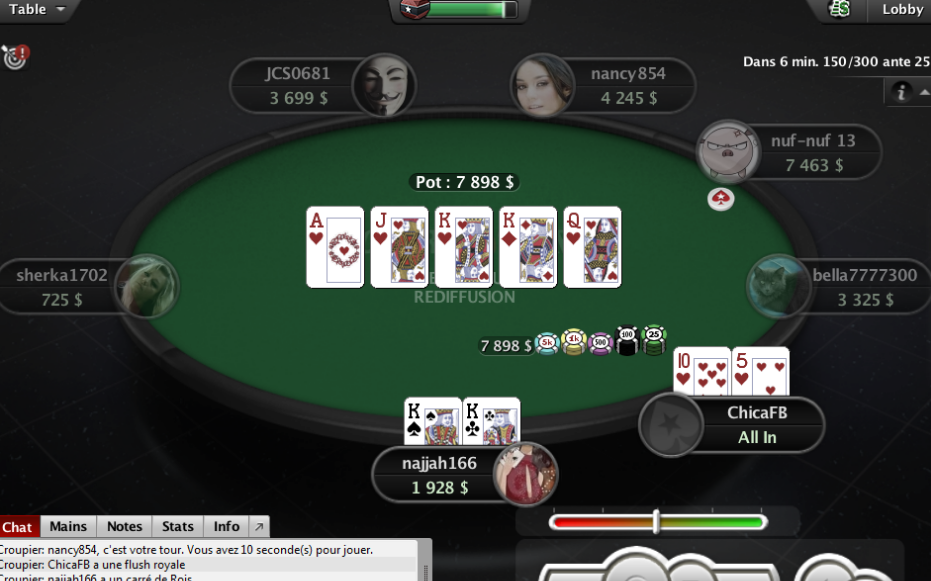Quad Aces Loses To Royal Flush
The $1.375 Million Bad Beat Jackpot Hit When A Royal Flush Beat Quad Queens. Nate 4/30/2018 9:46 AM. PokerNews - It had been eight months since the last bad beat jackpot was hit at Playground Poker Club. Back in August of 2017, the BBJ was hit at an incredible $1,210,989. Indeed, as you may have guessed from the title, what beats a quad aces is a straight flush. This is always the highest hand, although, depending on the cards that make up the straight, you can get a straight flush, made up of the five highest cards of the suit without counting kings or jacks, or a royal flush, made up of the ace, king, queen, soybean and the 10 of the corresponding one (of diamonds, clubs, spades or hearts, but it must be homogeneous, otherwise the straight flush.
I disagree with the 1 in 2.7 billion figure too. As you said, they seemed to calculate the probabilities independently for each player, for just the case where both players use both hole cards, and multiplied. Using this method I get a probability of 0.000000000341101, or about in 1 in 2.9 billion. Maybe the one in 2.7 billion also involves compounding a rounding error on both player probabilities. They also evidently forgot to multiply the probability by 2, for reasons I explain later.
There are three ways four aces could lose to a royal flush, as follows.
Case 1: One player has two to a royal flush, the other has two aces, and the board contains the other two aces, the other two cards to the royal, and any other card.
Example:
Player 1:
Player 2:
Board:

In most poker rooms, to qualify for a bad-beat jackpot, both winning and losing player must make use of both hole cards. This was also the type of bad beat in the video; in fact, these were the exact cards.
Case 2: One player has two to a royal flush (T-K), the other has one ace and a 'blank' card, and the board contains the other three aces and the other two cards to the royal.
Example:
Player 1:
Player 2:
Board:
Case 3: One player has one to a royal flush (T-K) and a blank card, the other has two aces, and the board contains the other two aces and the other three cards to the royal flush.
Example:
Player 1:
Player 2:
Board:
The following table shows the number of combinations for each case for both players and the board. The lower right cell shows the total number of combinations is 16,896.
Bad Beat Combinations
| Case | Player 1 | Player 2 | Board | Product |
|---|---|---|---|---|
| 1 | 24 | 3 | 44 | 3,168 |
| 2 | 24 | 132 | 1 | 3,168 |
| 3 | 704 | 3 | 1 | 2,112 |
| Total | 8,448 |
However, we could reverse the cards of the two players, and still have a bad beat. So, we should multiply the number of combinations by 2. Adjusting for that, the total qualifying combinations is 2 × 8,448 = 16,896.
The total number of all combinations in two-player Texas Hold ’Em is combin(52,2) × combin(50,2) × combin(48,5) = 2,781,381,002,400. So, the probability of a four aces losing to a royal flush is 8,448/2,781,381,002,400 = 0.0000000060747, or about 1 in 165 million. The probability of just a case 1 bad beat is 1 in 439 million. The simple reason the odds are not as long as reported in that video is that the two hands overlap, with the shared ace. In other words, the two events are positively correlated.
You are absolutely right, according to the paper Telling the Truth about New York Video Poker. The player’s outcome is indeed predestined. Regardless of what cards the player keeps, he can not avoid his fate. If the player tries to deliberately avoid his fate, the game will make use of a guardian angel feature to correct the player's mistake. I completely agree with the author that such games should warn the player that they are not playing real video poker, and the pay table is a meaningless measure of the player's actual odds. It also also be noted these kinds of fake video poker machines are not confined to New York.
I use your great site quite often, thanks! I found a new pay table at the Borgata in Atlantic City, for the Three Card Bonus bet in Let It Ride. They implemented these very recently, to the point the dealers were struggling to remember the new odds. Here is the new pay table: Mini Royal: 50 to 1
Straight flush: 40 to 1
Three of a kind: 30 to 1
Straight: 6 to 1
Flush: 4 to 1
Pair: 1 to 1
I am curious how it impacts the overall house edge.
That is not bad for a side bet. I show the house edge is 2.14%.


The probability of an event with probability p happening x times, out of a possible n, is combin(n,x) × px × (1-p)(n-x). In this case, p=4/9, x=4, and n=20. Here is the probability for all possible number of number of field rolls out of 20:
Bad Beat Combinations
| Wins | Probability |
|---|---|
| 0 | 0.000008 |
| 1 | 0.000126 |
| 2 | 0.000954 |
| 3 | 0.004579 |
| 4 | 0.015567 |
| 5 | 0.039851 |
| 6 | 0.079703 |
| 7 | 0.127524 |
| 8 | 0.165782 |
| 9 | 0.176834 |
| 10 | 0.155614 |
| 11 | 0.113174 |
| 12 | 0.067904 |
| 13 | 0.033430 |
| 14 | 0.013372 |
| 15 | 0.004279 |
| 16 | 0.001070 |
| 17 | 0.000201 |
| 18 | 0.000027 |
| 19 | 0.000002 |
| 20 | 0.000000 |
| Total | 1.000000 |
Taking the sum for 0 to 4, the probability is 2.12%. So, this could have easily happened in a fair game.
You’re welcome. If there are only two pirates left, then the one chosen to make a suggestion has no hope, because the other pirate will vote no. The one drawn will get zero, and the other all 1000. So, before the draw, the expected value with two pirates left is 500 coins.

At the three pirate stage, the drawn pirate should suggest giving one of the other pirates 501, and 499 to himself. The one getting 501 will vote yes, because it is more than the expected value of 500 by voting no. Before the draw, with three pirates left, you have a 1/3 chance each of getting 0, 499, or 501 coins, for an average of 333.33.
Do 4 Aces Beat A Royal Flush

At the four pirate stage the drawn pirate should choose to give 334 to any two of the other pirates, and 332 to himself. That will get him two ’yes’ votes from the pirates getting 334 coins, because they would rather have 334 than 333.33. Including your own vote, you will have 3 out of 4 votes. Before the draw, the expected value for each pirate is the average of 0, 334, 334, and 332, or 1000/4=250.
By the same logic, at the five pirate stage, the drawn pirate should choose to give 251 to any two pirates, and 498 to himself. Unlike the original problem, it isn’t necessary to work backwards. Just divide the number of coins by the number of pirates, not including yourself. Then give half of them (rounding down) that average, plus one more coin.
Happy Throwback Thursday to one and to all, for it truly is the best of all the weekdays.
Sometimes we like to throw it back to happy things, like Bill Belichick making peanut butter and jelly sandwiches. Other times we find ourselves walking down more painful paths. Today is one of those days.
Let’s return to January of this year, during the fourth day of the 2016 PokerStars Caribbean Adventure. There are lots of moving parts to this story but to avoid confusing all the non-poker players, this hand essentially came down to two players.
This guy, a frenchman called Paul Tedeschi…
And an Englishman called Phillip McAllister…
Tedeschi was holding pocket queens and hit another queen on the flop, giving him three of a kind.
In retrospect he should have just bought the pot right then and there, taken his profit and moved on. But he didn’t. He slow played things, trying to draw more money out of the other players. That, in the end, is what cost him. Tedeschi let the turn and then the river come before going all-in, thinking he had the hand won.
He didn’t.
McAllister was sitting on King-10 suited. Not bad, but he still looked destined to lose even after landing a queen on the flop. But then, the incredible: He hit a Jack of Hearts and and an Ace of Hearts on the turn and the river to complete a royal flush, the most powerful hand in poker.
Quad Aces Loses To Royal Flush
McAllister walked away with the 1.7 million chip pot and eliminated Tedeschi in the process. Strangely, he didn’t even look that happy about it.
Four Aces Loses To Royal Flush
Madness. Here’s the full video.